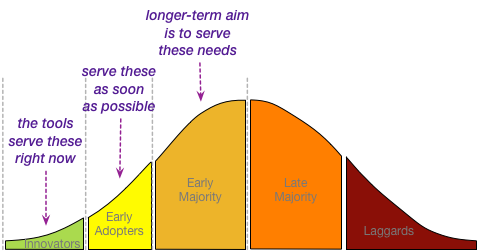The bucket-list – Patreon launch
We now have a Patreon funding-page! (If you don’t know Patreon already, it’s a bit like Kickstarter, but rather than Kickstarter’s one-off projects, it’s aimed more at ongoing activities, such as ours have been and will be here.)
We hope it’ll give a more solid foundation to support funding of the ongoing development of the ‘bucket-list’ of change-tools, and make them all more accessible and more generally available to everyone.
In terms of the Rogers technology-adoption model, most of the tools are suited only for a quite small subset of Innovators. If the tools are to be of real use, and to support more wide-scale, significant change and transformation, we’ll need to make new easier-to-use versions, as soon as possible, that fit well for the needs of a much broader range of Early Adopters. The real aim, though, is to make it usable all the way out to at least the Early Majority market:
The catch, of course, is that even the Early Adopters are a lot more demanding than Innovators; and Early Majority need it simplified much further again. (That’s not because they’re ‘stupid’, but because they need to be able to use it straight away, and know that it will work straight away, as-is – without their needing to tinker with it every step of the way, as Innovators are often wont to do… 🙂 )
As a comparison-example, consider the progression of Alex Osterwalder’s Business Model Canvas from its earliest Innovator-level academic version [PDF], to how it’s presented right now for its five-million-strong Early Majority market. That kind of shift takes a lot of effort, in many different forms, and a lot of cost, in many different senses – which is why, yes, we do need that support and seed-funding if this is going to happen in the time we need.
Yes, I’ve dithered way too long about setting up the Patreon, and I apologise to everyone for that – but it is now set up and running, and I’ve already started to sort out a planning, production and delivery schedule with my designer Joseph Chittenden. If you’ve been following this blog, you’ll already have seen some of his work – such as the new page-header above, based his suggested rework of the Five Elements model:
If you take a look at the previous post here, ‘An inventory, sorted‘, you’ll see that I’ve separated each of the tools into the Five Elements domain in which they most apply, and split them again into two groups, ‘primary’ and ‘support’. In effect, that gives us a basic priority-order and development-sequence:
- ‘priority’ before ‘secondary’
- ‘Pivot’ domain first, then Five Elements sequence (Purpose, People, Preparation, Process, Performance)
Which in turn indicates that the most urgent item of all is Five Elements itself. Which is what we’re working on right now.
One side-effect of starting the Patreon is that new developments will tend to get announced there first. (Their blogging-tool seems very limited, so I’ll have to find some other way to deliver the kind of work that you’ve seen here. More details to follow on that, anyway.) But I won’t be abandoning this blog – don’t worry about that!
In any case, many thanks for sticking with me this far – and let’s make this work, for everyone!


Tom – congratulations on launching the Patreon funding page.
A couple of thoughts for your consideration (and development) …
One of the elements that enterprises will need is an evolving architecture to support the ongoing evolution and sustainment of the pursuit of their enterprise.
The translates to a potential requirement for an evolving set of tools which support an evolving architecture underpinning an enterprise …
Your reference to business model canvas emphasised this for me, as I took a look at SCORE last night and was thinking about how my own “BMC 2.0” goes beyond the thinking of SCORE that you laid out quite a while ago …
Then your adopter model reinforced thinking about maturity models and suitable tools for different levels of maturity and evolving versions of tools as your lead / demanding clients enter new territories and create new demands for your toolset …
Looking forward to seeing how this evolves …